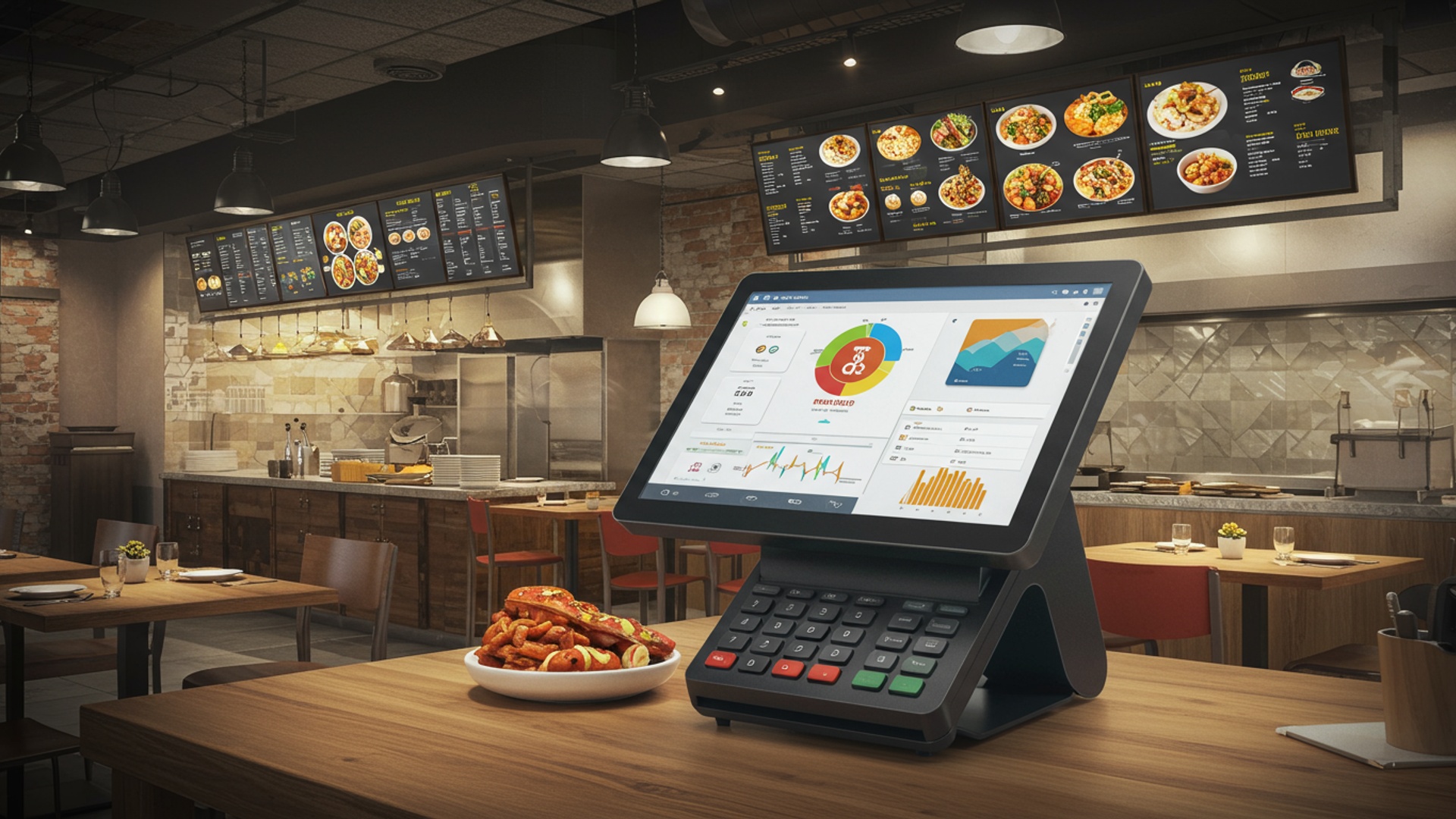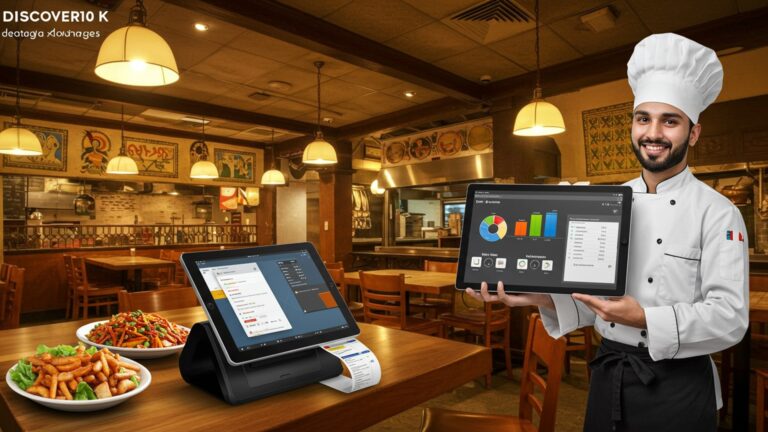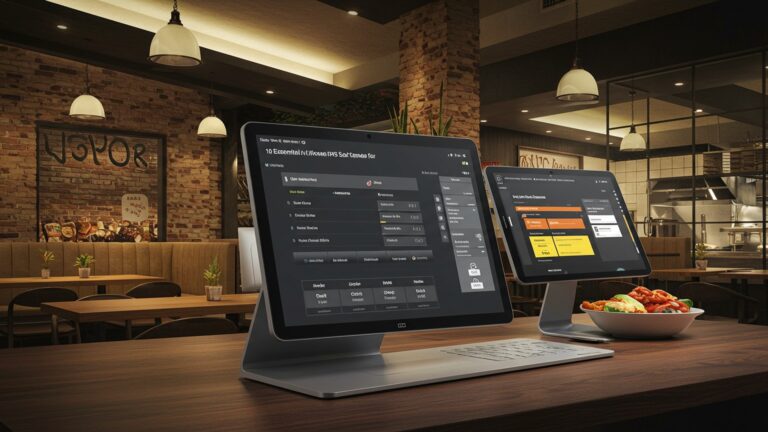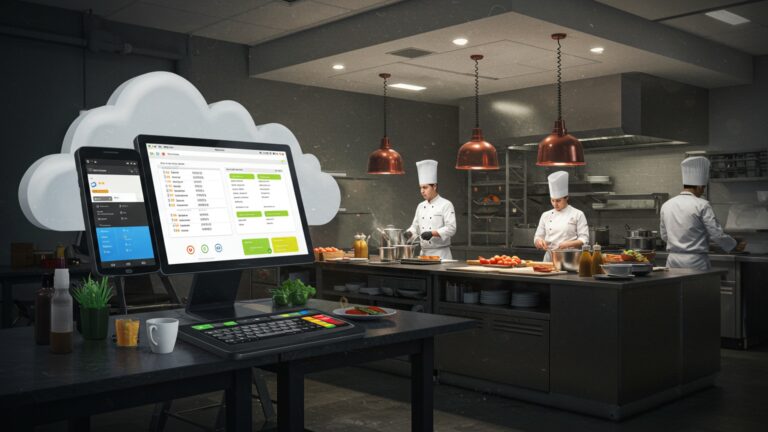How to Choose the Best Restaurant POS Software in India Guide
Navigating India’s fiercely competitive and rapidly digitalizing F&B landscape demands more than just a billing system; choosing the optimal Restaurant POS software India has become a strategic imperative. Modern cloud-native platforms, for instance, seamlessly integrate with third-party aggregators like Swiggy and Zomato, streamline QR-based ordering. flawlessly process ubiquitous UPI payments, reflecting recent developments in consumer behavior. This robust functionality moves beyond mere transactions, empowering operators to optimize inventory, minimize food waste, manage staff efficiently. cultivate deeper customer relationships, directly impacting profitability and service quality amidst rising operational costs.
Written by PromotoAI
promotoai generate content that ranks

Understanding Restaurant POS Software: More Than Just a Billing Machine
In the bustling culinary landscape of India, managing a restaurant efficiently is paramount to success. Gone are the days when a simple cash register sufficed. Today, the heart of a modern restaurant’s operations lies in its Point of Sale (POS) software. A POS system is essentially the central hub where all business transactions occur. It’s a sophisticated combination of hardware (like touchscreens, printers, cash drawers) and software that helps you manage everything from taking orders and processing payments to tracking inventory and analyzing sales data.
For Indian restaurants, a robust Restaurant POS software India solution is not just about billing; it’s about streamlining operations, enhancing customer experience. ultimately, boosting profitability. Think of it as your restaurant’s brain, coordinating various departments – the front-of-house, kitchen. back-office – to work in perfect harmony. From a small cafe in Bengaluru to a multi-cuisine restaurant chain across Mumbai, the right POS system can be a game-changer.
Key Features to Look for in Restaurant POS Software India
When you’re evaluating Restaurant POS software India options, it’s crucial to look beyond basic billing. A comprehensive system should offer a suite of features designed to address the specific needs of the food and beverage industry. Here are the essential functionalities to prioritize:
- Order Management (KOT & KDS)
- Kitchen Order Ticket (KOT)
- Kitchen Display System (KDS)
- Billing & Invoicing (GST Compliance)
- Inventory Management
- Table Management
- CRM & Loyalty Programs
- Reporting & Analytics
- Online Ordering & Delivery Integration
- Payment Gateway Integration
- Employee Management
- Multi-outlet Management
This is fundamental. The system should allow easy order taking, customization (e. g. , “no onions,” “extra spice”). efficient communication to the kitchen.
Automatically prints or displays orders in the kitchen.
A digital screen in the kitchen that displays incoming orders, helping chefs manage preparation times and reduce errors.
Seamless and quick bill generation is a must. Crucially, the software must be fully compliant with India’s Goods and Services Tax (GST) regulations, ensuring accurate tax calculations and easy report generation for tax filings.
Track raw materials and finished goods in real-time. This helps in reducing wastage, preventing stockouts. optimizing purchase orders. Imagine knowing exactly how many kilos of paneer you have left before the dinner rush, or how many bottles of a particular beverage you’ve sold in a week.
For dine-in restaurants, an interactive floor plan allows staff to manage table assignments, track the status of tables (occupied, vacant, reserved). split bills easily.
Build customer profiles, track their preferences. implement loyalty programs (e. g. , points, discounts, special offers) to encourage repeat business. This is vital for fostering customer relationships in a competitive market.
This is where data transforms into actionable insights. The software should generate detailed reports on sales, peak hours, popular dishes, staff performance. more, helping you make informed business decisions.
With the rise of food delivery platforms, seamless integration with services like Swiggy, Zomato, or your own online ordering portal is non-negotiable. This prevents manual order entry and reduces errors.
Support for various payment methods is crucial in India – cash, cards, UPI (Google Pay, PhonePe, Paytm). digital wallets. The POS should integrate with popular payment gateways for smooth transactions.
Track staff attendance, manage shifts, calculate commissions. monitor performance. Some systems even offer role-based access control, ensuring staff only access relevant functionalities.
If you operate multiple restaurant branches, the POS should allow centralized management of menus, inventory, pricing. reports across all locations.
Cloud-Based vs. On-Premise POS: Which is Right for Your Indian Restaurant?
One of the most significant decisions you’ll make when choosing Restaurant POS software India is whether to opt for a cloud-based or an on-premise system. Both have distinct advantages and disadvantages, especially in the Indian operational context.
- Cloud-Based POS
- On-Premise POS
Also known as SaaS (Software as a Service) POS, this system runs on remote servers and is accessed via the internet through a web browser or app. Data is stored securely in the cloud.
This traditional system involves installing the software directly onto your local servers and computers within the restaurant. Data is stored locally.
Comparison Table: Cloud-Based vs. On-Premise POS
| Feature | Cloud-Based POS | On-Premise POS |
|---|---|---|
| Cost Model | Subscription-based (monthly/annually), lower upfront cost. | One-time purchase, higher upfront cost (software + hardware + servers). |
| Accessibility | Access from anywhere, any device with internet. Ideal for multi-outlet management. | Limited to local network; remote access often requires VPN. |
| Maintenance & Updates | Managed by vendor, automatic updates. Less burden on restaurant owner. | Managed by restaurant (or IT staff); manual updates, potential downtime. |
| Data Security | Managed by vendor (often with robust security measures, backups). Requires trust in vendor. | Managed by restaurant; security depends on local IT infrastructure. |
| Internet Dependency | Requires stable internet; some offer offline mode with sync. essential consideration in areas with unreliable internet. | Less dependent on internet for core operations. updates/remote support might need it. |
| Customization | Generally less flexible, relies on vendor’s offerings. | More customizable to specific needs. at a higher development cost. |
| Hardware Needs | Often runs on standard tablets/PCs, flexible. | May require specific, more robust hardware and servers. |
For many Indian restaurants, especially those just starting or with multiple outlets, cloud-based Restaurant POS software India solutions often prove more appealing due to their lower upfront costs, remote accessibility. ease of maintenance. But, for establishments in areas with inconsistent internet connectivity, a robust on-premise system with an offline mode might be a safer bet.
Evaluating Scalability and Integration Capabilities
Your restaurant business isn’t static; it grows and evolves. The Restaurant POS software India you choose should be able to grow with you. This is where scalability and integration capabilities become critical.
- Scalability
- Integration Capabilities
- Accounting Software
- Third-Party Delivery Platforms
- HR & Payroll Systems
- Customer Relationship Management (CRM) tools
- Hotel Management Systems (PMS)
Can the system handle an increased volume of orders, more tables, or even additional outlets without a complete overhaul? A scalable POS ensures that as your restaurant expands, your software infrastructure doesn’t become a bottleneck. This means the ability to add more terminals, users, or even entire new locations seamlessly.
Modern restaurant operations involve various software tools. Your POS system should act as a central hub, communicating with other essential platforms. Look for robust API (Application Programming Interface) integrations with:
(e. g. , Tally, QuickBooks) for seamless financial reporting and reconciliation.
(e. g. , Swiggy, Zomato, Dotpe) to consolidate orders from various sources directly into your POS.
For managing staff data and payroll.
If your POS’s built-in CRM isn’t sufficient.
If your restaurant is part of a hotel.
A well-integrated system eliminates manual data entry, reduces errors. provides a holistic view of your business performance, freeing up valuable time for your staff.
User-Friendliness and Training Support
Even the most feature-rich Restaurant POS software India is useless if your staff can’t operate it efficiently. User-friendliness is paramount. An intuitive interface means faster order taking, quicker billing. reduced training time for new employees.
- Intuitive User Interface (UI)
- Training Resources
- On-site training
- Online tutorials & videos
- Comprehensive user manuals
- Local language support
The layout should be clean, logical. easy to navigate. Large, clear buttons, customizable menus. a logical workflow are key. A good way to assess this is by requesting a live demo and letting some of your current staff try it out.
What kind of support does the vendor offer for training? Look for:
Especially helpful during initial setup.
For ongoing learning and new hires.
For quick reference.
In a diverse country like India, having support and even the interface available in regional languages can significantly improve adoption and reduce errors among staff.
A smooth training process minimizes disruption and ensures your team can hit the ground running, maximizing the return on your investment in the Restaurant POS software India.
Cost Considerations and ROI of Restaurant POS Software India
Budget is always a significant factor. When evaluating Restaurant POS software India, it’s essential to look beyond the advertised price and consider the total cost of ownership (TCO) and the potential return on investment (ROI).
- Pricing Models
- Subscription-based (SaaS)
- One-time Purchase (On-premise)
- Hidden Costs
- Hardware
- Installation & Setup
- Training
- Support & Maintenance
- Integration Fees
- Payment Processing Fees
- Calculating ROI
- Reduce order errors and food wastage.
- Speed up service and table turnover.
- Improve inventory control, leading to less spoilage and optimized purchasing.
- Enhance customer loyalty, driving repeat business.
- Provide insights for better menu engineering and promotional strategies.
- Streamline accounting and reduce administrative overhead.
Most common for cloud POS. Monthly or annual fees per terminal or per location. Offers flexibility and lower upfront costs.
Higher upfront cost for software license. no recurring software fees.
Be wary of these:
Tablets, touchscreens, printers, cash drawers, network equipment. Some vendors offer bundles, others require you to source separately.
Fees for initial configuration and data migration.
Initial and ongoing training costs.
Annual contracts for technical support, software updates. bug fixes. Ensure these are clearly defined.
Costs associated with connecting your POS to other third-party software.
interpret the transaction fees charged by integrated payment gateways.
A good Restaurant POS software India should pay for itself through various efficiencies. Consider how it will:
A thorough cost-benefit analysis will help you interpret the true value the POS brings to your business.
Vendor Reputation and Local Support in India
Choosing a Restaurant POS software India provider isn’t just about the software; it’s about the partnership. The vendor’s reputation and the quality of their support, especially in the local Indian context, are critical for long-term success.
- Vendor Credibility
- Years in Business
- Customer Reviews & Testimonials
- Case Studies
- Local Support Structure
- Availability
- Channels
- Language
- Geographic Reach
A longer track record often indicates stability and experience.
Look for reviews on independent platforms and talk to other restaurant owners using their system. comprehend their experiences with the software and, more importantly, the support.
Do they have success stories from restaurants similar to yours in India?
In a vast and diverse country like India, local support is invaluable.
Is support available 24/7 or only during business hours? What are their response times?
Do they offer phone, email, chat. on-site support?
Can they provide support in regional Indian languages if needed?
Do they have a strong presence or support network in your city or region? This is crucial for hardware issues or on-site troubleshooting.
Poor support can quickly turn a great software into a nightmare, leading to operational downtime and frustrated staff. Prioritize a vendor known for reliable and accessible customer service.
Security and Data Protection
In an age of increasing cyber threats and data privacy concerns, the security features of your Restaurant POS software India are non-negotiable. You’re handling sensitive customer data, payment insights. critical business financials.
- PCI DSS Compliance
- Data Encryption
- Data Backup and Recovery
- User Access Controls
- Cloud Security Measures
If your POS processes credit card payments, it must be Payment Card Industry Data Security Standard (PCI DSS) compliant. This set of security standards ensures that all companies that process, store, or transmit credit card details maintain a secure environment.
Ensure that all data, especially payment insights, is encrypted both in transit (when it’s being sent) and at rest (when it’s stored).
What are the vendor’s backup protocols? In case of system failure, data loss, or a disaster, how quickly and effectively can your data be recovered? Cloud POS systems typically offer robust automated backups. it’s essential to confirm.
The system should allow you to define roles and permissions for different staff members. For example, a cashier might only have access to billing, while a manager has access to reports and inventory. This prevents unauthorized access and potential internal fraud.
If opting for a cloud POS, inquire about the vendor’s data center security, firewalls, intrusion detection systems. regular security audits.
Protecting your business and customer data should be a top priority when selecting any Restaurant POS software India.
Actionable Steps: Your Checklist for Choosing the Best Restaurant POS Software India
Navigating the options for Restaurant POS software India can be daunting. with a structured approach, you can make an informed decision. Here’s an actionable checklist to guide you:
- Assess Your Specific Needs
- What kind of restaurant do you run (fine dining, quick-service, cafe, bar, multi-outlet)?
- What are your biggest pain points with your current system (or lack thereof)?
- What features are absolutely essential. which are “nice-to-haves”?
- What is your budget for both initial setup and ongoing costs?
- How reliable is your internet connectivity?
- Research Potential Vendors
- Look for vendors with a strong presence and positive reputation in the Indian market.
- Read online reviews, testimonials. industry reports.
- Shortlist 3-5 Restaurant POS software India providers that seem to fit your criteria.
- Request Detailed Demos
- Schedule personalized demos with each shortlisted vendor.
- Ask specific questions tailored to your restaurant’s operations.
- Pay close attention to user-friendliness, feature depth. integration capabilities.
- Talk to Other Restaurant Owners
- Reach out to peers in the industry, especially those with similar restaurant types.
- Ask about their experiences with different POS systems, particularly regarding support and reliability in India.
- Clarify All Costs and Contracts
- Get a clear breakdown of all costs: software, hardware, installation, training, support. any hidden fees.
- comprehend the contract terms, including cancellation policies, data ownership. upgrade paths.
- Evaluate Support and Training
- Test their customer support responsiveness before committing.
- Ensure they offer comprehensive training and accessible support channels, ideally with local presence.
- Prioritize Security
- Confirm PCI DSS compliance and data security measures.
- grasp their data backup and recovery policies.
- Start with a Trial (if available)
- Many vendors offer free trials or pilot programs. Take advantage of these to test the system in a real-world scenario before making a full commitment.
By following these steps, you’ll be well-equipped to select a Restaurant POS software India solution that not only meets your current needs but also supports your future growth and success.
Written by PromotoAI
promotoai generate content that ranks
Conclusion
Choosing the ideal restaurant POS software in India isn’t merely a purchase; it’s an investment in your establishment’s future. We’ve explored how critical features like robust KOT management, seamless online ordering integration. comprehensive GST compliance are for the bustling Indian culinary scene. Remember, the true power lies in a system that adapts to your unique workflow, from a small cafe to a multi-outlet chain, rather than forcing you to adapt to it. My personal tip is to always prioritize a free demo and speak directly with vendors about their local support infrastructure. In today’s competitive landscape, where digital payments and cloud-based solutions are the norm, your POS should be a strategic partner, not just a billing tool. Embrace a system that simplifies operations, delights customers with efficient service. provides actionable insights for growth. The right choice will not only streamline your daily tasks but also empower you to scale your culinary dreams across India’s vibrant food industry. For more insights into broader POS trends, consider exploring resources on the evolution of point-of-sale systems.
More Articles
Discover the 7 Best Restaurant POS Software Options for Seamless Operations
Learn How to Implement POS Software for Cloud Kitchen Success in India
5 Essential Features Your POS Billing Software Needs for GST Compliance
Discover the 7 Best POS Software Solutions in India for Your Business
Learn 8 Smart Ways POS Software Streamlines Inventory Management
Written by PromotoAI
promotoai generate content that ranks
FAQs
What’s the very first thing I should consider when choosing POS software for my restaurant in India?
Start by understanding your restaurant’s unique operational needs. Are you a quick-service joint, a fine-dining establishment, a cafe, or do you focus heavily on delivery? Your specific workflow and service model will dictate the essential features you need, like table management, KDS (Kitchen Display System), inventory tracking, or robust online ordering integrations.
How crucial is the cost. are there often hidden fees with restaurant POS systems in India?
Cost is definitely essential. don’t just look at the initial price. Factor in subscription fees (monthly/annually), hardware costs, implementation charges, training fees. ongoing support costs. Some vendors might have lower upfront costs but higher recurring fees or charge extra for essential modules. Always ask for a detailed breakdown of all potential expenses to avoid surprises.
What are some must-have features for a restaurant POS in the Indian market?
Beyond basic billing, look for comprehensive inventory management (crucial for food costs!) , detailed reporting and analytics, integrated table management, CRM for customer loyalty. robust online ordering integration. GST compliance is non-negotiable, so ensure the system handles it seamlessly. Kitchen Display Systems (KDS) and waiter ordering apps can also be game-changers for efficiency.
Should I opt for a cloud-based POS or a traditional on-premise system?
For most modern Indian restaurants, a cloud-based POS is generally recommended. It offers flexibility, remote access to reports, automatic updates. lower upfront hardware costs. On-premise systems can work offline but require more maintenance and a larger initial investment. Cloud solutions are often more scalable and better for managing multiple outlets.
My restaurant relies heavily on online food delivery apps like Swiggy and Zomato. What should I look for in a POS?
Integration with major Indian food aggregators is absolutely critical. Look for a POS that can seamlessly receive orders from Swiggy, Zomato. others directly into your system. This avoids manual entry errors, saves time. helps consolidate all your orders and sales data in one place for better reporting and inventory management.
How do I evaluate different POS vendors to make sure I pick the right one?
Beyond features and price, check the vendor’s reputation and experience in the Indian market. Read reviews, ask for references. see how responsive their sales and support teams are. A good vendor should comprehend the local nuances, offer reliable customer support (preferably 24/7). have a proven track record.
Is getting a demo or free trial really necessary before committing to a POS?
Absolutely! A demo or trial is crucial. It lets you test the software’s usability, see if it fits your specific workflow. ask all your burning questions. Don’t just watch a sales presentation; get hands-on experience to ensure the interface is intuitive for your staff and that all the advertised features actually work as promised for your business.






